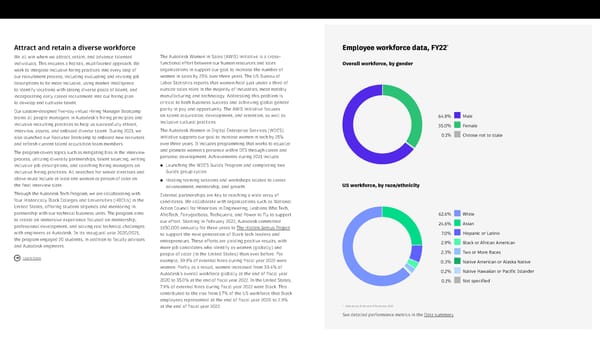Attract and retain a diverse workforce Employee workforce data, FY22* We all win when we attract, retain, and advance talented The Autodesk Women in Sales (AWiS) initiative is a cross- individuals. This requires a holistic, multifaceted approach. We functional effort between our human resources and sales Overall workforce, by gender work to integrate inclusive hiring practices into every step of organizations in support our goal to increase the number of our recruitment process, including evaluating and revising job women in sales by 25% over three years. The US Bureau of descriptions to be more inclusive, using market intelligence Labor Statistics reports that women hold just under a third of to identify locations with strong diverse pools of talent, and outside sales roles in the majority of industries, most notably incorporating early career recruitment into our hiring plan manufacturing and technology. Addressing this problem is to develop and cultivate talent. critical to both business success and achieving global gender Our custom-designed five-day virtual Hiring Manager Bootcamp parity in pay and opportunity. The AWiS initiative focuses trains all people managers in Autodesk’s hiring principles and on talent acquisition, development, and retention, as well as 64.9% Male inclusive recruiting practices to help us successfully attract, inclusive cultural practices. 35.0% Female interview, assess, and onboard diverse talent. During 2021, we The Autodesk Women in Digital Enterprise Services (WDES) also launched our Recruiter Bootcamp to onboard new recruiters initiative supports our goal to increase women in tech by 25% 0.1% Choose not to state and refresh current talent acquisition team members. over three years. It includes programming that works to equalize The program covers topics such as mitigating bias in the interview and promote women’s presence within DES through career and process, utilizing diversity partnerships, talent sourcing, writing personal development. Achievements during 2021 include: inclusive job descriptions, and coaching hiring managers on ● Launching the WDES Guilds Program and completing two inclusive hiring practices. All searches for senior directors and Guilds group cycles above must include at least one woman or person of color on ● Hosting training sessions and workshops related to career the final interview slate. advancement, mentorship, and growth US workforce, by race/ethnicity Through the Autodesk Tech Program, we are collaborating with External partnerships are key to reaching a wide array of four Historically Black Colleges and Universities (HBCUs) in the candidates. We collaborate with organizations such as National United States, offering student stipends and mentoring in Action Council for Minorities in Engineering, Lesbians Who Tech, partnership with our technical business units. The program aims AfroTech, Fairygodboss, Techqueria, and Power to Fly to support 62.6% White to create an immersive experience focused on mentorship, our effort. Starting in February 2022, Autodesk committed 24.6% Asian professional development, and solving real technical challenges $150,000 annually for three years to The Hidden Genius Project with engineers at Autodesk. In its inaugural year 2020/2021, to support the next generation of Black tech leaders and 7.0% Hispanic or Latino the program engaged 20 students, in addition to faculty advisors entrepreneurs. These efforts are yielding positive results, with 2.9% Black or African American and Autodesk engineers. more job candidates who identify as women (globally) and people of color (in the United States) than ever before. For 2.3% Two or More Races Learn more example, 39.9% of external hires during fiscal year 2022 were 0.3% Native American or Alaska Native women. Partly as a result, women increased from 33.4% of 0.2% Native Hawaiian or Pacific Islander Autodesk’s overall workforce globally at the end of fiscal year 2020 to 35.0% at the end of fiscal year 2022. In the United States, 0.1% Not specified 7.9% of external hires during fiscal year 2022 were Black. This contributed to the rise from 1.7% of the US workforce that Black employees represented at the end of fiscal year 2020 to 2.9% at the end of fiscal year 2022. * Data are as of the end of fiscal year 2022. See detailed performance metrics in the Data summary.
 Autodesk Impact Report Microsite Page 49 Page 51
Autodesk Impact Report Microsite Page 49 Page 51